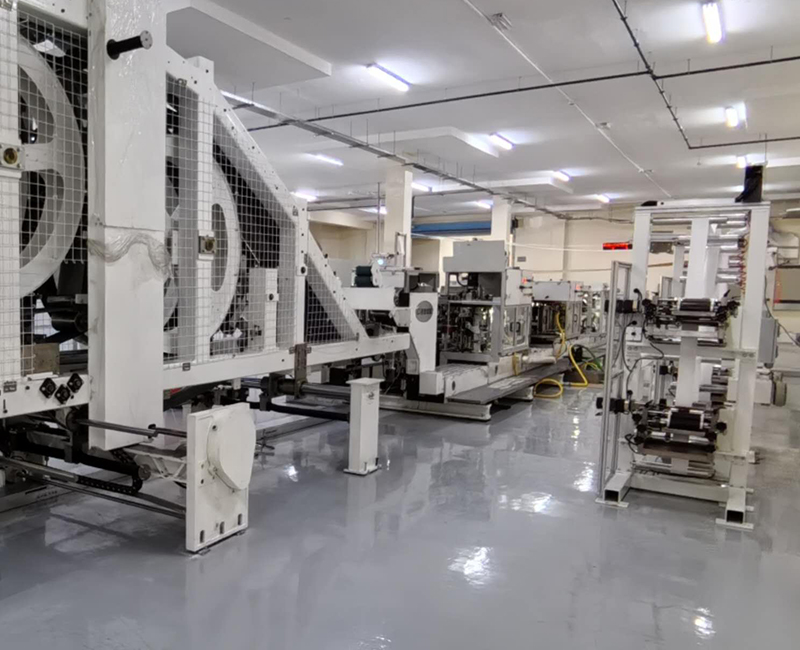Paper Bag Manufacturing Machines vs. Plastic Bag Manufacturing Machines: A Comprehensive Comparison
Release time:2025-05-19 Classification:Knowledge
The global shift toward sustainable packaging solutions has intensified the debate between paper and plastic bag production technologies. Manufacturers and businesses seeking to align with environmental goals or optimize operational efficiency must carefully evaluate the differences between paper bag machines and plastic bag machines. This article provides an in-depth analysis of both systems, covering their mechanisms, material requirements, environmental impacts, and industrial applications.

1. Fundamental Differences in Material Processing
Paper bag machines and plastic bag machines operate on distinct principles due to the inherent properties of their raw materials.
- Paper Bag Machines:
These systems process cellulose-based materials, such as kraft paper or recycled paper rolls. The production typically involves unwinding, printing (if required), cutting, folding, gluing, and pressing. Advanced machines incorporate automated systems for handle attachment and precision creasing. Since paper lacks inherent plasticity, adhesives and heat-sealing techniques are critical for structural integrity. - Plastic Bag Machines:
Plastic bag manufacturing relies on thermoplastic polymers like polyethylene (PE) or polypropylene (PP). The process begins with extruding molten resin into thin films, which are then cooled, cut, and sealed using heat or ultrasonic welding. High-speed machines can produce thousands of bags per hour, leveraging the malleability of plastics for seamless sealing and customization.
2. Energy Consumption and Production Speed
Operational efficiency varies significantly between the two technologies.
- Paper Bag Machines:
Paper production demands substantial energy during the pulping and drying stages, but converting paper into bags is relatively energy-efficient. Modern machines prioritize precision over speed, with average outputs ranging from 50 to 200 bags per minute, depending on complexity (e.g., handles, gussets). - Plastic Bag Machines:
Plastic extrusion and film-blowing processes are energy-intensive, yet the high-speed nature of these machines offsets energy costs. Outputs often exceed 500 bags per minute for simple designs, making them ideal for mass production. However, ultrathin plastic films require meticulous temperature control to avoid defects.
3. Environmental Impact and Sustainability
The ecological footprint of each machine type is a critical consideration.
- Paper Bag Machines:
Paper bags are biodegradable and compostable, aligning with circular economy principles. However, their environmental benefits depend on responsible forestry practices and water-efficient manufacturing. Energy consumption and chemical use in bleaching or coating processes can offset sustainability gains if not managed properly. - Plastic Bag Machines:
Conventional plastic bags contribute to long-term pollution due to their resistance to degradation. While recyclable in theory, inadequate waste management systems limit real-world recycling rates. Innovations like oxo-degradable additives or bio-based plastics aim to mitigate these issues, but scalability remains a challenge.
4. Cost Considerations and Maintenance
Initial investment and operational costs differ markedly.
- Paper Bag Machines:
These systems often require higher upfront costs due to the need for precision components (e.g., glue applicators, folding arms). Maintenance focuses on minimizing paper jams and ensuring adhesive consistency. Raw material costs fluctuate with pulp market prices, which are influenced by global demand and regulatory policies. - Plastic Bag Machines:
Lower upfront costs and faster production speeds make plastic machines appealing for high-volume orders. However, maintenance involves frequent cleaning of extruder dies and monitoring of heating elements to prevent resin degradation. Dependency on fossil fuel-derived resins exposes operators to price volatility.
5. Application-Specific Advantages
Choosing between paper and plastic bag machines depends on end-use requirements.
- Paper Bags:
Ideal for retail, luxury goods, and food packaging where durability and eco-friendly branding are priorities. Reinforced handles and multi-ply designs cater to heavier loads. - Plastic Bags:
Preferred for lightweight, waterproof applications such as grocery shopping, garment covers, or industrial packaging. Their flexibility and moisture resistance ensure versatility in diverse climates.
6. Regulatory and Market Trends
Governments worldwide are enacting bans on single-use plastics, driving demand for paper alternatives. Conversely, industries requiring hygienic, low-cost solutions continue to rely on plastic bag machines. Hybrid technologies, such as paper-plastic laminates, are emerging but face scalability hurdles.
The choice between paper bag machines and plastic bag machines hinges on balancing sustainability objectives, operational budgets, and market demands. Paper bag systems excel in eco-conscious markets, while plastic bag machines dominate high-volume, cost-sensitive sectors. As material science advances, both technologies are evolving to address environmental concerns without compromising functionality. Manufacturers must stay informed about regulatory shifts and consumer preferences to make strategic investments in these critical production systems.






